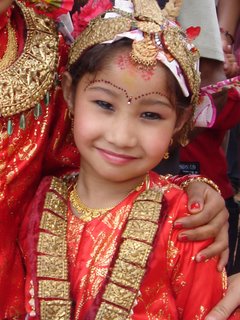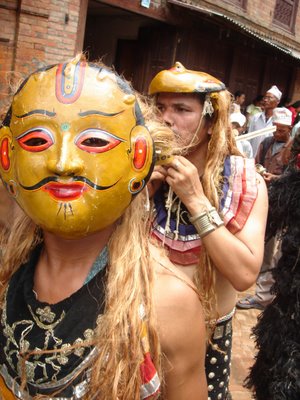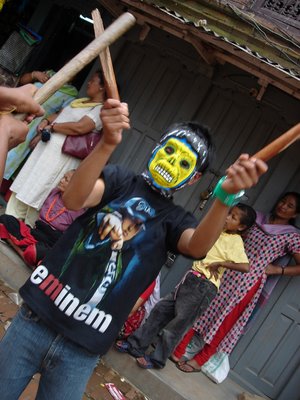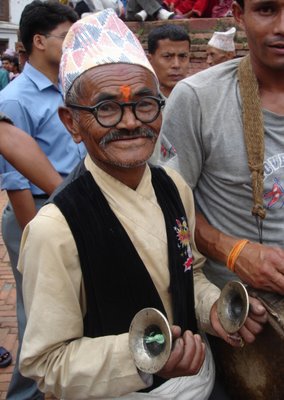Bhaktapur, Nepal

Our week of celebrating the coming Nepali festival season got off to a bad start. Floriane (a Belgian student here studying the outcaste women of Nepal) and I went out to Boudha to witness something of Janai Purnima (which falls on the August full moon). I was hoping to see the Jhankris, or Tamang shamen, dance around the stupa. We saw some awesome artwork at the new Nyima monastery, and emerged to find Floriane's shoes had been stolen. (Expensive Teva sandals, a present from her mother.) It must be extra rotten karma to steal from a visitor to a Buddhist monastery - and extra extra rotten on a holy day.
Maybe the guilty person will be reborn as a cow - that is, an unfortunate western cow - whose hide will be used to make shoes.
On Thursday, Floriane and I made for Bhaktapur to watch yet another quintessentially Nepali holiday (Nepaliday?)
Gai Jatra (Cow Pilgrimage) is a sort of Nepali version of the Mexican Dia de los Muertos, or Day of the Dead. Each family who has lost a member during the previous year constructs a "gai" of bamboo branches, cloth, paper decorations and portraits of the deceased. The belief is that a cow must lead the dead spirits into the next land, but it's rare to see a real cow involved. Instead,they construct the "thaha macha" or "false cow." Each thaha macha looms overhead like a swaying radio tower. They bamboo tower is often covered with cloths that belonged to the deceased - black for women, white for males.
The looming, swaying photos paraded unblinking through the streets reminded me of the Monty Python line - "bring out your dead!!"

The families (usually males, but sometimes women help) cart this contraption through the narrow streets on their shoulders.
We took a local bus from Ratna Park
 (the central bus stand inKathmandu) out to Bhaktapur. A one-hour ride: total cost, 20Rs or fifty cents (a taxi is nearly $10 US). There are two buses, though, one that makes all local stops and another that's faster - we fortunately got the faster one. In classic Asian fashion we sat on the covered gear-shift to give a proper seat a breast-feeding mom, who was as surprised as she was grateful.
(the central bus stand inKathmandu) out to Bhaktapur. A one-hour ride: total cost, 20Rs or fifty cents (a taxi is nearly $10 US). There are two buses, though, one that makes all local stops and another that's faster - we fortunately got the faster one. In classic Asian fashion we sat on the covered gear-shift to give a proper seat a breast-feeding mom, who was as surprised as she was grateful.Gai Jatra is also a day for transvestism, political satire, free speech, stick-dancing in the streets, and general goofiness and masking. In a sort of combination April Fool's and Halloween, "mad" comic papers of crazy news and political spoofs are printed. It was a long, hot sweaty day in the streets, but so much fun we didn't realize how dehydrated we were till it was long over (at which point I nearly keeled over and had to spend the night at Bhadgaon Guest House).


For kids, it's turned into a sort of all-purpose Halloween type holiday and I saw many plastic western-style masks. SpiderMan is especially popular with both little boys and girls.

 All the guide books describe Gai Jatra as a one-day thing. In Bhaktapur (literally, "city of devotion") it's the beginning of a week-long festival. Every day sees different processions, with various street dances and costumes, till the final day of Krishna Janmashtami (Krishna's birthday).
All the guide books describe Gai Jatra as a one-day thing. In Bhaktapur (literally, "city of devotion") it's the beginning of a week-long festival. Every day sees different processions, with various street dances and costumes, till the final day of Krishna Janmashtami (Krishna's birthday).All the guide books describe Gai Jatra as a one-day thing. In Bhaktapur (literally, "city of devotion") it's the beginning of a week-long festival. Every day sees different processions, with various street dances and costumes, till the final day of Krishna Janmashtami (Krishna's birthday).

The legend (every festival has a legend) is that a queen of long ago lost her favourite son. She
 was inconsolable in her grief. Finally the king had enough of it and designed this festival to show her that others had suffered the same losses during the year, so she should get over herself. It also helps the town make a light-hearted celebration of their loved ones and helps everyone get over their mourning stage.
was inconsolable in her grief. Finally the king had enough of it and designed this festival to show her that others had suffered the same losses during the year, so she should get over herself. It also helps the town make a light-hearted celebration of their loved ones and helps everyone get over their mourning stage.Every generation has a role to play in Gai Jatra and even if you did not lose a member of your family, you are expected to help your friends get all the Sacred Stuff together, so it reinforces community bonds (says the anthropologist that lives in my head. Dr Wells would be proud!)

It's supposed to be a harvest time festival (like most days honouring the dead), but because it follows a lunar calendar, it gets earlier every year. In a few decades I guess they will be parading in the heat of the May sun. Maybe they adjust it every hundred years or so to avoid this.


In late afternoon, after having paraded their dead relatives all over town for a final look-see, the Cow Towers end up at the absolutely stunning Nyatapola Square, with its towering pagodas, and assemble in a moving circle, resembling some kind of huge MayDay dance.


At the parade's end well after dark, the False Cows are taken to the edge of the river, hacked apart with hand-axes and all the disposable parts - bamboo, paper cow-face decor, tinsel and straw - are tossed in the water, which ripples under the silvery full moon.

If you missed it, don't worry. In Nepal, there's always another festival next week.














2 comments:
VIEWER MAIL
Kingshuk in Bangalore writes:
Coming this side anytime?
Another very standard question for you: Do you plan to write a book anytime soon? I see it in the bestseller's chart. As an Indian, I would enjoy reading it too!
Take care!
Another Spreaad out Indian plainsman
VIEWER MAIL
Troy in Nashville writes:
Fascinating stuff, and great pics too, Caroline! Great to have our roving reporter out there to bring the world to us homebound Middle-Tennesseans.
luv ya....
Post a Comment